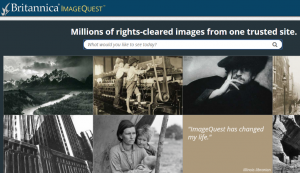You may have noticed that instructors, professors, and librarians spend a lot of time and effort talking about the importance of citation and referencing so that you can avoid plagiarism, but what you may not know is that it is equally important to make sure you understand how to fairly use images, film, and other visual content to avoid breaking copyright law.
We’ve all heard the adage “a picture is worth a thousand words,” and it’s true that including an image or video clip in an essay or presentation can not only look more professional, but can also often provide your audience with meaningful information that is difficult to put into words. Therefore, this guide encourages you to include images and visual material when applicable- but just make sure you’re doing it legally.
The processes for using digital media can be confusing and varied, so let’s go over some of the most important concepts related to accessing and obtaining content online to keep you on track:
1- You can’t use every image you find on the internet. If there is one thing you take away from reading this post, please make it this! It may seem inconvenient, but it’s true. It is important to understand that, unless explicitly stated, any image, film, or other digital object you find or access through the internet (or in print) should be considered protected under copyright law. There are no exceptions. If it makes you feel better, every picture you’ve ever physically captured and posted on Instagram belongs to you- from every plate of food to pictures of your pet being amazing- they’re all protected under copyright.
2- There are plenty of images you can use. There are plenty of websites offering access to Creative Commons images that are not copyrighted and available for use, including:
- Flickr Creative Commons
- Unsplash
- Pixabay
- New Old Stock photos
- Tineye Labs
- Wikimedia Commons
- British Library Online Gallery
- Library of Congress Prints and Photographs Online
3- What exactly is Creative Commons? Creative Commons (CC) is a global nonprofit organization that enables sharing and reuse of creativity and knowledge through the provision of free legal tools. With regard to images, CC is a type of copyright license that is designed specifically to work with the web, which makes content that is offered under terms easy to search for, discover, and use. In other words, when you use images licensed under CC, you won’t be breaking copyright law.
4- There are some exceptions. There are different licenses affiliated with CC, which are often combined to tell you how an image or resource can and can NOT be used, including:
- Attribution (by) This CC license requires that you credit the creator when you use their work in any, however, you may not suggest the creator endorses you or your use of the resource. If you want to use their work without giving them credit, or for endorsement purposes, you must get permission from the creator first.
- Sharealike (sa) You can copy, distribute, display, perform, and modify someone’s work, as long as you distribute any modified work on the same terms. In other words, if you crop an image or change it in anyway, the new image, if licensed at all, must be done as a Sharealike image, unless you get permission from the original creator.
- Noncommercial (nc) You can copy, distribute, display, perform, and (unless the item is also licensed under NoDerivatives) modify and use someone’s work for any purpose other than commercially, unless you get their permission first.
- NoDerivatives (nd) You can copy, distribute, display and perform only original copies of someone’s work. If you want to modify their work, you must get permission first.
Make sure that when you use a CC image, that you properly cite it. A typical CC image attribution would look like this:

Photo by Jakob Owens on Unsplash licensed under Creative Commons Attribution-Sharealike 4.0 International
5- That seems like a long process- are you sure I have to do ALL of that? Yes. Actually, double yes. While it’s tempting to think that you would never be accused of stealing copyrighted images since you’re likely using them under Fair Use, it is still vitally important that you understand and actively engage in the process of adequately using images. Not only will you impress your instructors and fellow students with your knowledge about how to properly use images, your current or future employer will appreciate your professionalism and integrity.
6- What about the images I find using CSN Libraries image databases? Due to Fair Use, if you plan on using images from the numerous CSN Libraries image databases for an assignment, you are in luck! Just make sure you provide an in-text citation as well as a reference in your Bibliography or Works Cited page.
Following copyright with regard to the fair use of images can be a complicated process, but just remember, you have several options and tools at your disposal, and, above all, there’s always a librarian at every CSN campus who will be happy to help support you and your future success here at the college!



